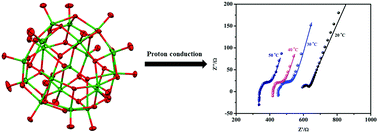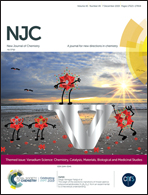A fully reduced {V IV18O42} host and VO43−, Cl− as guest anions: synthesis, characterization and proton conductivity†
Abstract
Fully reduced polyoxometalates (POMs) generally have a high negative charge that can be compensated by diverse cations including protons. The POMs with a large number of acidic protons often exhibit solid state proton conduction. We synthesized two polyoxovanadate (POV)-based compounds, [Na7(H2O)14][H8VIV18O42(VVO4)]·N2H4·7H2O (1) and [Na5(H2O)16][H8VIV18O42(Cl)]·4N2H4·6H2O (2), each of which accommodates eight acidic protons (per formula unit) acting as the cations. Compounds 1 and 2 have been characterized by routine analytical techniques, such as, IR, Raman, XPS, PXRD, TGA, etc., elemental analysis, and unambiguously by single crystal X-ray diffraction. As expected, compounds 1 and 2 having eight protons per formula unit exhibit proton conductivity in the solid state. Proton conductivity measurements of compounds 1 and 2 were performed (a) at variable temperature (20–50 °C) at constant humidity (70% RH) and (b) variable humidity (relative humidity from 40% to 70%) at constant temperature (30 °C). The proton conductivity was observed to increase with an increase in temperature and humidity. The best conductivity values were obtained at 50 °C at a RH of 70% and found to be 3.62 × 10−3 S cm−1 for compound 1 and 2.16 × 10−4 S cm−1 for compound 2. Reproducibility of proton conductivity was verified by repetitive data recording over a long time period and determining the mean value of conductivity of compounds 1 and 2 at 50 °C. The activation energies for 1 (23.34 kJ mol−1) and 2 (18.40 kJ mol−1) calculated from Arrhenius plots of temperature dependence of proton conductivity suggest a Grotthuss proton hopping mechanism for solid state proton conduction. Controlled experiments have shown that the synthesized compounds 1 and 2 are stable and robust under operational conditions.

- This article is part of the themed collection: Vanadium Science: Chemistry, Catalysis, Materials, Biological and Medicinal Studies


 Please wait while we load your content...
Please wait while we load your content...